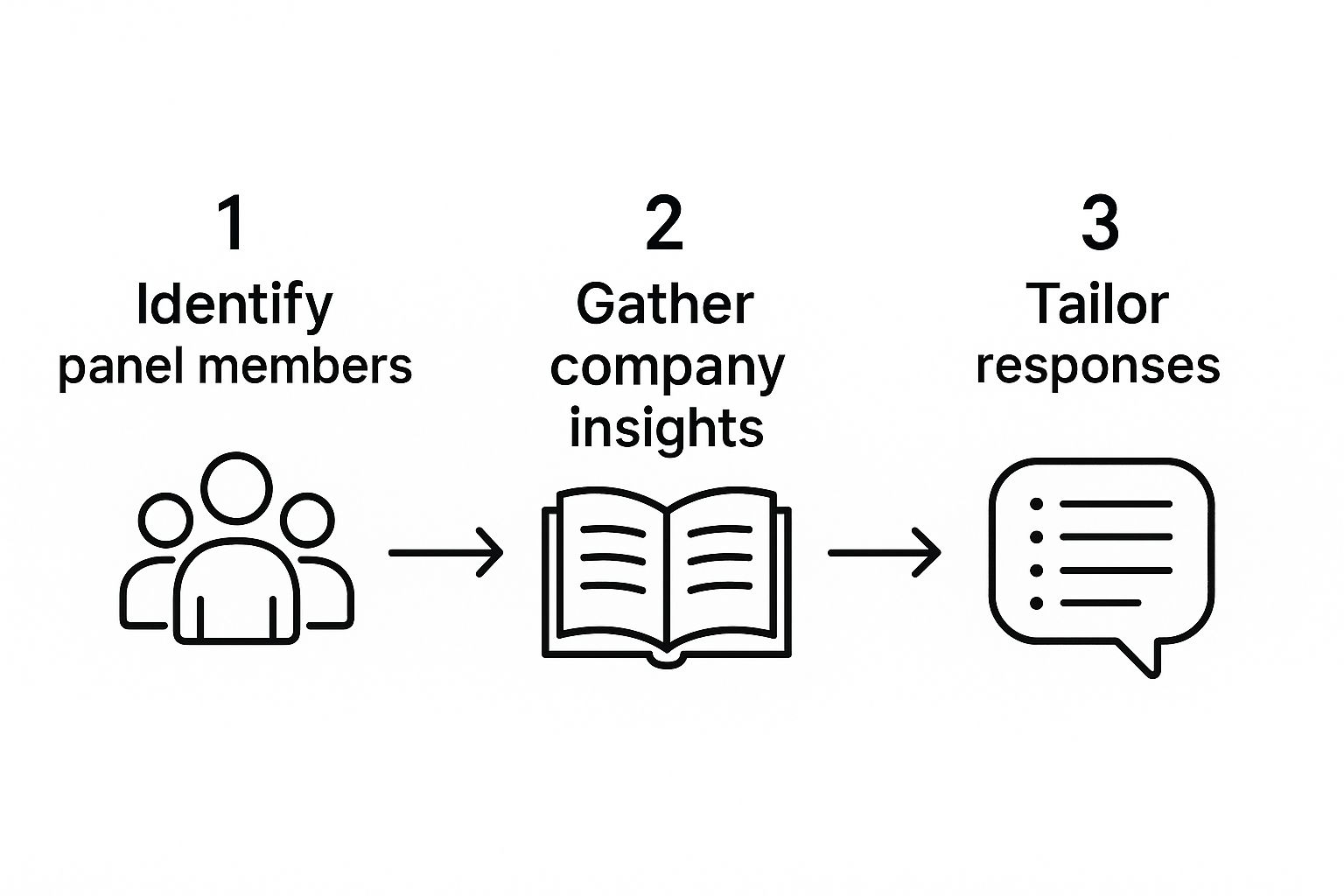
How to Prepare for a Panel Interview and Succeed
Facing a panel interview can feel daunting, but a bit of smart preparation can transform it from an interrogation into a conversation. It’s all about knowing your audience, having your stories straight, and being ready to connect with several key people at once. Think of it less as a performance and more as a chance to show a whole team why you’re the right fit.
Cracking the Code of the Panel Interview

When you walk into a room and see three, four, or even five faces looking back at you, it’s easy to feel like you’re on stage. But here’s the inside scoop: companies don’t use panels to scare you. They do it to make a smarter, more balanced hiring decision.
This format is becoming the new normal. With some reports indicating that around 90% of companies now incorporate video interviews—many of which are panel-style—it’s a skill you need to master. And in a tough job market where only about 2% of applicants typically make it past the first interview, every advantage counts. You can dig deeper into job interview statistics to see just how competitive things are.
Why Do Companies Bother With Panels?
Simply put, it’s efficient and gives them a much clearer picture of who you are. Every person in that room is looking at you through a different lens, which helps them build a well-rounded assessment and minimizes the risk of one person’s gut feeling or bias swaying the decision.
More importantly, it’s a live-action test of your professional skills. They’re watching to see:
- How you manage group dynamics: Can you hold the attention of a room and connect with people who have different roles and priorities?
- Your ability to adapt: How do you respond when questions are fired from different directions, one right after the other?
- Your team chemistry: This is their first real glimpse of how you might collaborate and communicate with your future colleagues.
Once you understand what they’re looking for, you can reframe the situation. This isn’t an obstacle; it’s a golden opportunity to win over multiple decision-makers in one shot. It’s your chance to prove you’re a great communicator and a natural collaborator.
Ready to get started? Here’s a quick checklist to guide your preparation.
Your Panel Interview Prep Checklist
This table breaks down the essential steps to make sure you walk into your interview feeling prepared and confident.
| Preparation Phase | Key Action | Why It Matters |
|---|---|---|
| Audience Research | Identify each panelist and their role. | Allows you to tailor answers to their specific interests and concerns. |
| Story Crafting | Prepare 3-5 versatile career stories. | Gives you concrete examples to answer a wide range of questions. |
| Delivery Practice | Rehearse out loud, not just in your head. | Builds confidence and helps you make natural eye contact with everyone. |
| Logistics Check | Confirm details for in-person or virtual setups. | Prevents last-minute stress so you can focus on the conversation. |
| Follow-Up Strategy | Draft personalized thank-you notes. | Reinforces your interest and leaves a lasting positive impression. |
Taking the time to work through these steps will make a huge difference.
Who You Can Expect to See on the Panel
Knowing your audience is half the battle. Your panel will almost always be a deliberate mix of people you’ll work with, so you need to anticipate what each one cares about.
A typical lineup often includes:
- The Hiring Manager: This is your potential boss. They want to know if you have the hard skills to get the job done and deliver results.
- Future Teammates: These are the people you’ll be in the trenches with. They’re wondering, “Are you competent, and will you be a good colleague to work with every day?”
- A Cross-Functional Leader: Think of someone from a department you’ll collaborate with, like Product or Marketing. They’re gauging how well you’ll work with their team to achieve shared goals.
- An HR Representative: This person is focused on the bigger picture—your alignment with company culture, your salary expectations, and whether you fit the company’s values.
Do Your Homework—The Smart Way
Showing up to a panel interview knowing the company’s mission statement is the bare minimum. If you really want to make an impact, you need to go deeper. Think of it less like studying for a test and more like strategic reconnaissance. Your goal is to figure out how your skills and experience can solve their specific problems.
LinkedIn is your best friend here. Don’t just glance at job titles. Dig into each panelist’s profile. What’s their career path been like? What kind of articles or posts do they share? What are their specialties? You’re looking for clues that tell you what they value. And while you’re there, a strong profile of your own never hurts; you can find some great advice on how to optimize your LinkedIn profile to make sure you’re putting your best foot forward.
Figure Out What Each Panelist Cares About
Once you have the names of your interviewers, you can start to anticipate their questions. Everyone in that room has a different job and, therefore, a different set of priorities. They’ll be listening to your answers through their own unique filter.
Imagine you’re walking into a room with this crew:
- The VP of Sales: They’re thinking about one thing: revenue. They want to know how you can help them acquire new clients, shorten sales cycles, and grow the business. Frame your accomplishments around that.
- The Head of Engineering: This person lives in a world of technical execution, product stability, and innovation. They’ll want to hear about your problem-solving process, your technical chops, and how you approach building things.
- The HR Manager: They are the gatekeeper of company culture. They’re trying to figure out if you’ll be a good teammate, how you manage conflict, and whether you see a long-term future at the company.
Each person needs to hear how you fit into their world.

This process really boils down to three things: identify who you’re talking to, understand the bigger picture of the company, and then connect your story to both.
Go Beyond the “About Us” Page
To really shine, you need to know what’s happening at the company right now. The corporate website is a good starting point, but it’s often just marketing material. You need to find the real story.
Here’s where to look for the good stuff:
- Recent Press Releases: These are perfect for finding out about new products, big partnerships, or major company milestones. Casually mentioning a recent launch shows you’re genuinely interested and on top of things.
- Quarterly Investor Calls: If it’s a public company, transcripts from these calls are pure gold. This is where leaders get real about what’s working, what isn’t, and where they’re headed.
- Industry News: What are other people saying about the company? Reading articles from trade publications gives you a much broader perspective on their position in the market and against their competitors.
When you can connect your experience to a recent company achievement or a strategic goal you heard mentioned on an investor call, the entire conversation changes. You’re no longer just another candidate answering questions—you’re a strategic partner who has already started thinking about how to help.
The group dynamic of a panel interview is precisely why this level of preparation is so critical. You’re not just speaking to one person; you’re trying to win over a team with diverse, and sometimes competing, priorities. According to research on group interview dynamics from experts at Coursera, knowing each panelist’s name, role, and likely focus beforehand dramatically increases your ability to engage them effectively.
Crafting Your Core Career Stories

Here’s a common trap I see people fall into: trying to memorize the “perfect” answer for dozens of potential interview questions. It’s a recipe for a stiff, robotic performance.
A much better way to prepare is to build a mental portfolio of your 5-7 core career stories. These are your greatest hits—the moments you stepped up, solved a thorny problem, and made a real, measurable impact.
Think of these stories as your versatile toolkit. One powerful story about a challenging project can be bent and shaped to answer questions about leadership, problem-solving, teamwork, or resilience. It all depends on which part of the story you emphasize. This way, you’re never caught flat-footed; you always have a compelling, evidence-backed narrative ready to go.
Building Stories with the STAR Method
The STAR method is your best friend for structuring these stories. It’s a classic for a reason—it forces you to be clear, concise, and impactful, which is exactly what a panel of busy people wants to hear. Most behavioral questions are practically begging for a STAR-formatted answer.
Here’s the breakdown:
- Situation: Quickly set the scene. What was the project? What was the challenge?
- Task: What was your specific goal or responsibility?
- Action: What specific steps did you personally take? Get into the details here.
- Result: What was the outcome? Quantify it whenever possible.
That last part—the Result—is where most candidates lose their momentum. Vague claims like “I improved the process” are totally forgettable. You have to connect your actions to a tangible business outcome to make them stick.
Don’t just say, “I improved efficiency.” That means nothing. Instead, try: “I automated a weekly reporting task with a simple script, which saved our team 10 hours of manual work every single week.” Now that’s a result they’ll remember.
From Vague Claims to Concrete Wins
Let’s walk through a real-world example. Imagine a panelist from the marketing team asks, “Tell me about a time you had to work with a difficult stakeholder.”
A weak answer sounds like this: “I had to work with a product manager who was really demanding. I just kept communicating with them, and eventually, we got the project done.” It’s generic and shows very little.
Now, let’s rebuild that same experience using the STAR method:
-
(S) Situation: “In my last role, we were launching a new feature, but the lead product manager and I had conflicting ideas for the messaging. He was focused entirely on the technical specs, while I knew from experience that our customers respond to benefit-driven language.”
-
(T) Task: “My job was to find a middle ground that satisfied his need for technical accuracy but also ensured the campaign would actually resonate with our audience and hit our lead generation targets.”
-
(A) Action: “Instead of getting into a debate, I pulled the data from our three most successful past campaigns. It clearly showed that headlines focused on ‘saving time’ had a 35% higher click-through rate than ones listing product specs. I presented this in a quick meeting and proposed a new headline structure that incorporated both of our ideas.”
-
(R) Result: “He saw the data and agreed to test my proposed messaging. The campaign ended up exceeding our lead goal by 15%, and that framework became our new standard for product launches. More importantly, he and I built a great working relationship from that point on.”
See the difference? The second story is packed with proof. It showcases collaboration, data-driven thinking, and a focus on results, all in one tight narrative.
Prepare Questions That Show You’re a Contributor
Remember, an interview is a two-way street. The questions you ask the panel are just as important as the answers you give. This is your chance to show them how you think. Please, avoid generic questions about company culture.
Ask questions that prove you’ve done your homework and are already thinking like a member of the team.
- “I saw in your latest quarterly report that you’re expanding into the European market. What are some of the biggest challenges the product team is anticipating with that launch?”
- “When project timelines get tight, how does your team typically navigate cross-functional disagreements, say between engineering and marketing priorities?”
- “If I were to step into this role, what would success look like after six months? What are the key metrics I’d be measured against?”
Questions like these leave a lasting impression. They signal that you aren’t just looking for any job—you’re looking to get in there and make a real impact.
Getting Your Gameday Logistics and Delivery Dialed In
Knowing your stuff is one thing, but delivering it with polish and confidence when you’re under the microscope? That’s what truly lands the job. The secret is getting all the little logistical details out of the way—whether you’re in person or on a video call—so you can pour all your mental energy into the conversation itself.
With so many companies embracing remote work, virtual panel interviews are more common than ever. This means you’ve got to become a mini-tech expert. It’s not an exaggeration; a staggering 62% of candidates have run into technical glitches during a virtual interview. That’s a huge number, and it makes a thorough tech check an absolute must. You can dig into more trends like this by checking out these essential job interview statistics.
Your Virtual Interview Tech Checklist
A seamless virtual interview doesn’t just happen. You have to make it happen. Run through this list the day before your interview, and then do a quick check again about an hour beforehand. Trust me, it beats last-minute panic.
- Look the Part (On Camera): Get that camera set up at eye level. Nobody wants to look up your nose. Check the framing—you want your head and shoulders clearly visible so it feels like a real conversation, not a security camera feed.
- Sound Crystal Clear: Your laptop’s built-in mic is probably not going to cut it. A headset or an external microphone is your best bet for crisp, clear audio. Do a test recording to make sure you don’t sound like you’re in a wind tunnel.
- Set the Scene: Lighting is everything. Make sure your main light source is in front of you, not behind you, to avoid looking like a silhouette. Your background should be clean and distraction-free. A simple, tidy room or a professional virtual background is perfect.
- The All-Important Connection: A dodgy internet connection is a dealbreaker. If you can, plug directly into your router with an Ethernet cable. It’s far more stable than Wi-Fi and can save you from a frozen screen at a critical moment.
The goal here is to make the technology disappear. When everything just works, the panel can focus on you and what you’re saying, not on troubleshooting a bad connection. A flawless setup sends a strong message: you’re professional and you come prepared.
How to Actually Connect with a Remote Panel
Building rapport through a screen takes a bit more deliberate effort. You can’t rely on the natural energy of being in the same room, so you have to create it.
Here’s a pro tip that feels weird but works wonders: look directly into the camera lens when you’re talking. To the people on the other side, it will feel like you’re making direct eye contact. It’s a small change that projects a ton of confidence.
Also, use their names. When a panelist asks you a question, kick off your answer with something like, “That’s a great point, Sarah.” It’s a simple touch that builds a personal connection and shows you’re engaged and paying attention to who’s in the “room.”
If you’re heading to an in-person interview, the details are different but just as critical. Map out your route and plan to arrive 10-15 minutes early—always build in a buffer for traffic or transit delays. Lay out your outfit the night before so you aren’t scrambling in the morning. Getting these details sorted ahead of time means you can walk into that office calm, collected, and ready to make a great impression.
Executing a Memorable Follow-Up

The interview doesn’t really end when you hang up the call or leave the building. Your follow-up is the final, crucial piece of the puzzle—it’s your last chance to leave a lasting, positive impression and stand out from a sea of other qualified candidates.
Too many people treat this step as a formality, dashing off a generic thank-you note. That’s a huge mistake. To make an impact, your message has to be personal for each panelist. This small effort shows you were genuinely listening and valued each person’s time and input, which speaks volumes about your professionalism.
Crafting a Personalized Thank-You Email
Specificity is your best friend here. Sending the exact same email to everyone on the panel is a massive missed opportunity. Your goal is to tailor each message to the actual conversation you had with that specific person.
Think back to your discussion with each interviewer. What stood out? You can jog their memory and reinforce your connection by referencing things like:
- A project they’re excited about: “I really enjoyed hearing about the new user onboarding flow you’re spearheading. It sounds like a fantastic initiative.”
- A specific question they asked: “Thanks for your question about how I handle tight deadlines. It got me thinking further about the project management techniques I could bring to the team.”
- A shared interest or background: “It was great to connect over our shared passion for sustainable tech.”
Little details like these prove you weren’t just on autopilot. It elevates your follow-up from a polite formality to a genuine extension of your conversation. If you need more inspiration, our guide on how to write a compelling application follow up email has some great templates.
A personalized follow-up does more than just say ‘thank you.’ It reinforces your key strengths, shows you were paying close attention, and demonstrates a high level of professionalism and enthusiasm for the role.
Timing and Professional Patience
When it comes to follow-ups, timing is critical. You want to send your personalized thank-you emails within 24 hours of the interview. This ensures you’re still fresh in their minds and shows you’re both proactive and organized.
Once you’ve hit send, the hardest part begins: the wait. It’s essential to be patient and let the hiring process unfold. Don’t be tempted to bombard them with messages. If the timeline they gave you comes and goes, a single, polite check-in about a week later is perfectly fine. Anything more can start to feel desperate.
Have confidence that your thorough preparation, strong interview performance, and thoughtful follow-up have made your case.
The Kinds of Questions You Can Expect in a Panel Interview
You can’t read the interviewers’ minds, but you can anticipate the types of questions they’ll ask. Panel interviews almost always circle back to the same core themes: how you behave, how you think, and how you’ll get along with the team.
The trick isn’t to memorize answers. It’s to have your key career stories ready, so you can adapt them to whatever comes your way. This is a huge part of learning how to properly prepare for a panel interview.
Behavioral and Situational Questions
This is where the rubber meets the road. Panelists love behavioral questions because they’re based on a simple premise: past performance predicts future success. They want proof, not just promises.
These questions almost always start with “Tell me about a time when…” or “Give me an example of…” They’re digging for real-world evidence of how you handle common workplace challenges.
Get ready for questions like these:
- Conflict: “Walk me through a disagreement you had with a colleague. What was the outcome?”
- Pressure: “Tell us about a time you were up against a tight deadline with multiple priorities. How did you manage it?”
- Adaptability: “Describe a major change at a previous job. How did you adjust?”
- Failure: “Tell me about a project that failed. What did you take away from that experience?”
The absolute best way to answer these is with the STAR method (Situation, Task, Action, Result). It’s a classic for a reason. It forces you to tell a concise story that has a clear beginning, middle, and end, and most importantly, it highlights the Result. That’s the part that sticks in their minds.
If you’re new to the workforce, don’t worry. You can pull from academic projects, internships, or even volunteer work. You can get a feel for this by reviewing common entry-level interview questions to start building your stories.
Questions About Team and Culture Fit
Remember, they aren’t just hiring a walking skill set—they’re hiring a future coworker. The panel needs to feel confident that you’ll be a positive addition to their team dynamic and the broader company culture.
So, you’ll likely hear things like:
- “What kind of work environment helps you thrive?”
- “How do you like to get feedback from your boss and your teammates?”
- “On a team project, what role do you naturally find yourself playing?”
This is your moment to show you know yourself. Be genuine about what you need to do your best work, but also show that you’re flexible and ready to collaborate. This is where that pre-interview research on company values really pays off, helping you connect your personal style to their stated mission.
Problem-Solving and Strategic Thinking Questions
Finally, they want to see your brain in action. These questions are designed to test how you analyze problems and think strategically. They might throw a hypothetical business case at you or ask you to deconstruct a complex problem you’ve solved in the past.
Be on the lookout for prompts like:
- “When you’re faced with a complex problem, what’s your process for solving it?”
- “Can you give an example of a time you spotted a potential problem and addressed it proactively?”
- “How do you make a sound decision when you don’t have all the data?”
For these, your thought process is the real answer. Don’t just jump to the conclusion. Talk them through how you think. Show them your logic, step-by-step, to prove you’re a methodical and creative problem-solver.
At Jobcamp, we believe that smart preparation is the key to landing your dream job. Our AI-powered tools help you create perfectly tailored resumes and cover letters in minutes, so you can focus on acing the interview. Stop spending hours on documents and start getting more callbacks. https://www.jobcamp.ai

